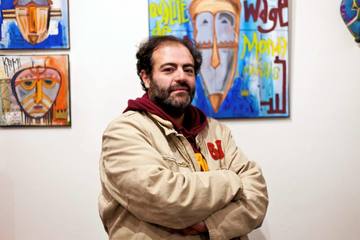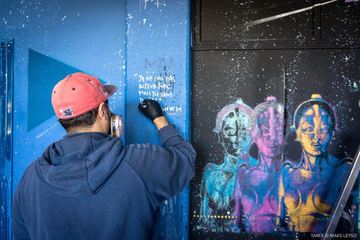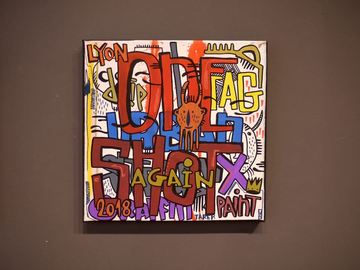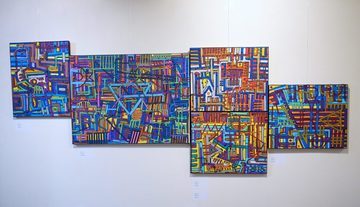A key figure in Street Art, Tarek has several feathers in his cap, so to say. As a writer, comics illustrator, photographer, graffiti artist and painter, his resumé is long and his accomplishments vast. Let’s meet this prolific contemporary street artist!
By Cécile Martet | 22 Aug 2023

Hello Tarek! So first of all, let’s go back to the roots! What triggered your desire to become an artist?
What triggered my desire to become an artist was surely my discovery of graffiti at the end of 1986 on my first trip to London. I was fifteen years old, I was alone, and I knew from the moment I saw graffiti in the tube that this was something for me. It wasn’t like the art you see in museums…it was “wild art” and it was for me.

Did you go to school to become an artist?
I actually have a degree in medieval history and art history from the Sorbonne in Paris. I didn’t have any training in an art school but I learned some things from artists with whom I collaborated on comics. I am curious by nature and, thanks to my numerous trips, I was able to visit most of the great museums, whether in Berlin, London, New York, Paris, Athens, Rome, etc.

What inspires you?
Reading essentially…Then, I would say travels and meetings with other artists who have a very different approach from mine. Comics, calligraphy, oriental art and certain artists are all sources of inspiration.
And precisely, who are the artists that have most inspired and guided you?
Picasso for his longevity, his vision and his ability to constantly question himself. He is one of the painters I admire the most. Mondrian, Miro, Malevitch, Klee, Kandinsky and Delaunay for their way of painting and expressing themselves through color and abstract forms.
Basquiat for voodoo and Pop art for its critique of society. Marcel Duchamp, Alechinsky, Soulages and Hopper for having explored paths with a virtuosity and vitality that touch me. Moebius for his exceptional drawing (and also because I met him several times).

What’s your take on today’s urban scene?
I’m pleasantly surprised by the democratisation of this art form, which was originally disparaged and associated with delinquency. When I was a teenager, I never thought that graffiti would take me to galleries all over the world. Today, everything is different! Urban art is part of the art market and speculation in this branch of contemporary art has not yet reached record levels.

However, I have a feeling that in the years to come urban art is likely to become a way for artists who have no real practice in the urban space to find a collecting public that has all too often been scalded by the speculative bubbles in contemporary art. In the street, creativity is alive and well. New young talents are joining the older ones, revitalising the graffiti scene.
The Paris metro is coming back to life and that’s great news for those who love this art form. I’m confident about the future of this form of artistic expression, but we still need to remain vigilant.
“Art, in my opinion, is a path that leads to freedom, the freedom that lies behind the veil of the illusions of materiality. That’s why I’ve chosen to follow this difficult path without taking the easy way out. It’s a battle I have to fight every day, but a noble one.



